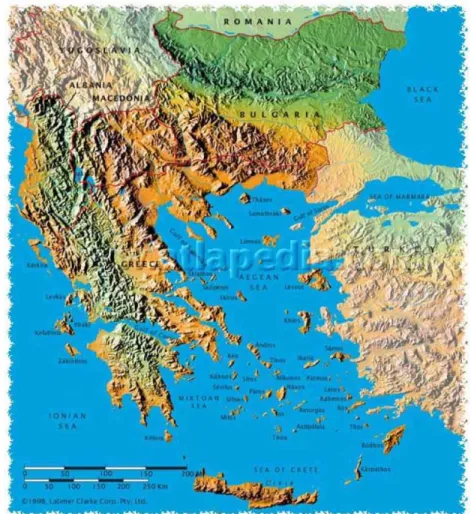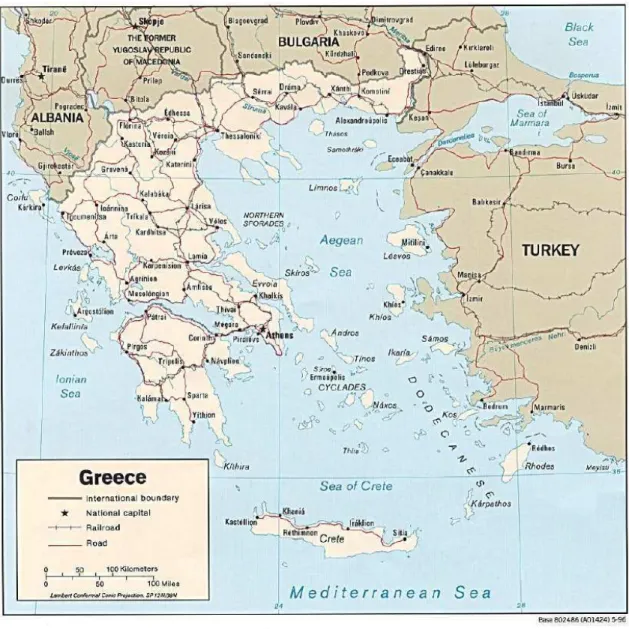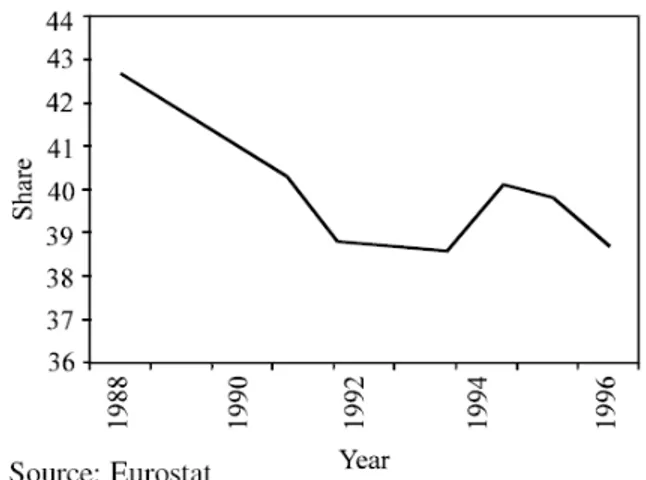ISSN 1546-9239
© Science Publications, 2004
The Impact of the TENs Program on the Greek Economy
1
Paris Tsachouridis and
2Andreas Cholopoulos
1Technological Educational Institute of Thessaloniki, Greece
2University of Macedonia, Greece
Abstract: This is a short survey of the impact of the Trans-European Program on the Greek economy.
Greece is a predominantly mountainous country and as such has never developed a dense transportation network grid. On the other hand, Greece is making an extensive use of European funding to modernize its infrastructures and this is expected to have a considerable impact on the Greek economy.
Key words: Economic Development, Regional Development, Trans-European Networks, Greece
INTRODUCTION
The European Union as a concept reveals the evolution of the European thinking. Postwar Europe based on the lessons given by history, developed a frame for cooperation and systematically turned the nationalistic and expansionistic attitudes into a deep desire for peace and made the case of the war practically unthinkable.
This has been a long but steady process, taking place since 1957, year of the establishment of the European Economic Community, until today. A process, that has gradually led to the European Union, the EMU and other achievements.
Since 1990, year of the publication of the Action Plan, it has become clear, that Europe suffered from national state oriented infrastructures and had to develop Trans- European networks to interconnect the existing national transport, energy and telecommunications networks. This need was formally recognized in the Treaty for the European Union as a priority and the EU established two Intergovernmental groups (Christophersen and Bangemann groups) to investigate the subject and prepare priority lists for the projects to be implemented. Today, nine years since the Maastricht Treaty, many projects have been completed, others are to be completed soon and some have not even started being implemented. At the same time major problems have emerged and revealed the extent to which this program is over ambitious.
First of all, constructing or improving the infrastructures on a continental level, requires enormous funds, which of course is impossible to acquire from the European Union budget. At the same time, there are problems of coordination, legislation, technical and geographical obstacles.
The sector of transport is the one which requires the most funds. Especially in the case of roads, there must be national funding, since there is no particular
interest in the private sector. The liberalization of the rail market should normally stimulate the private sector and attract investment. Public/private partnerships for airports administration seem also a good idea as part of the effort to attract private investment.
The sector of Energy networks is also widely dependent on the national programs, but here as well there is potential for private involvement.
The Sector of Telecommunications is perhaps the most liberal and at the same time the one that requires the least funds, since the private sector appears very dynamic and the European Union has mainly to standardize the market.
The TENs program has a major impact on the European Economies, both directly, in terms of investment and employment and indirect, in terms of development and growth[1]. Saw this program as a new version of the old strategy of the “New Deal” implemented by the EU in an attempt to trigger economic development in the United. Moreover,[2] asserts that this is the first action of the economic policy of the E.U.
This study tries to assess the extent to which the TENs program boosts the Greek economy, one of the smallest and the weakest economies of the European Union.
The Greek economy and infrastructure prior to
1992: The Greek economy was seriously
underdeveloped prior to 1992, in all possible terms. There was very high inflation, very low growth rate and very limited investment, both private and public.
countries were making efforts to re-constructs their economies, kept Greece back in national poverty and under-development.
Right after the civil war and following the association of Greece with the European Economic Community (in 1961), the growth rate of the Greek economy was exceptionally high from 1961 to 1979 the average annual growth was 6%[4]. But this was mainly because of the high protectionism the Greek state applied and did not imply any infra-structural projects or development. In combination with the ineffective and rapidly growing public sector, this led to the ill economy of the 1980’s.
In the 1980’s the Greek state was widely dependent on external borrowing in order to shift the public debt and to pay wages and at the same time wasted significant funds, from the European Community.
That happened because instead of directly investing the European funds, the Greek government included those funds in the public investment budget (that money was not added to the budget, but it replaced money previously acquired from taxes, money that was now used to reduce the public deficit,[4].
It was in the early 90’s when the budget deficit started decreasing and Greece used the European structural/cohesion funds effectively.
Nevertheless, at that time the need for more infrastructures became intense, since the lifestyle of the average Greek became more demanding (i.e. many families have more than one car) and the Greek industry was trying to catch up with the rest European partners. The Greek State found itself unprepared to satisfy the increased demand.
Transport TENs direct impact: Before we proceed
with the impact the TENs program has on the Greek economy it is important to quote here what the priority projects are and what other projects are also being implemented.
The Christophersen committee suggested that the following projects are of major importance for the Greek economy, both for reasons of boosting investment and for reasons of cohesion:
1. PATHE (Patras, Athens, FYROM), north-south axis
2. Via Egnatia (Istanbul, Thessaloniki, Igoumenitsa→
Italy), east-west axis
3. Spata Airport, Athens (Source: Trans European Networks[5]
At the same time, the Railway Public Enterprise, OSE, has applied a modernization programme, which will improve the links between south and north and east and west. More specifically, the program implies a two
way rail connection between Patras and Evzonoi, at the Greek-FYROM border, with the last part (Thessaloniki- Evzonoi) running electro-trains and a two way rail connection between Istanbul and Igoumenitsa.
The Greek state has also improved the Macedonia Airport (Thessaloniki), by upgrading the Terminal Station, extending the airplane park and updating the Control Tower.
Finally, Greece with the financial aid of the European Union Regional Development Fund (ERDF), is developing infrastructures to connect poor and distant regions to the above backbone.
The overall cost of the priority projects only, is € 8,000 M[5]. This, in addition to the cost of the rest of the project, shows the ambitious extensive attempt of Greece to modernize its infrastructures and confront the challenges of the new economic era emerging in Europe.
For a better understanding of the impact of these projects, the reader should be aware of the geography of Greece, both physical and political (Fig. 1 and 2).
Greece is predominantly a mountainous country. This prevents the development of road and rail networks compared to the ones of north Europe, such as the British rail network. On the other hand, there is no real need for such infrastructures, since most of the population and the economic activity is located by the seaside. Athens has a population of about four million people, Thessaloniki one million and Patras over one hundred and fifty thousand people. In other words, the backbone networks will interconnect more than fifty per cent of the Greek population (10 million) and a greater fraction of the Greek economic activity. At the same time the above networks, will connect Greece with its neighbors, the Balkans on the north border, Turkey and Asia to the East and Italy to the West.
The importance of the PATHE is probably the most obvious. It will interconnect the three major industrial cities of Greece and at the same time the three major ports (Athens, Thessaloniki, Patras). It has been estimated that the European Union looses every year € 1,2-2 because of traffic congestion, about 2% of the EU GDP for the year 1991[6]. So connecting the major areas of economic activity with better infrastructures is significantly important in the battle against high transport costs and other externalities.
Fig. 1: Physical Map of Greece Source: www.atlapedia.com
The project supports the role of Greece as an economic power in the Balkans and at the same time provides the other countries with a safe and reliable passage from East to West and vice versa (i.e. Turkish immigrants in Western Europe, prefer to travel to their country through Italy and Greece, despite the fact their way would be shorter through the Balkans).
The Spata airport has a great importance for the Greek economy. The other two airports of Athens are located in an urban area, heavily populated and thus high air traffic causes safety and sound pollution problems. The existing two airports are also very small and incapable of serving the increasingly high demand, especially looking to the prospective Olympic Games of 2004.
Spata Airport is also considered as a major accelerating factor of the local tourism.
The improved railways are not of course expected to boost tourism, but they will also provide the Greek economy with important benefits. The Athens- Thessaloniki axis is expected to cover the 500 Km of distance in less than 4 hours (intercity service) and provide a good alternative to those who prefer a shorter, safer and more comfortable journey than the one by car
(approximate length ~5 hours). At the same time, the slower trains will offer a cheap alternative to freight transportation, from Athens to Thessaloniki and from there to the markets abroad (Italy, Balkans, Turkey).
Energy TENs direct impact: The priority energy
TENs projects in Greece (most of them have been completed) are the following:
∗ Electricity interconnection between Greece and Italy (submarine cable). Cost € 300 million
∗ Natural gas network. Cost € 1500 million
As aforementioned, after 1990 Greece accelerated its development program, especially through investment expenditure of the public enterprises, but the demand expanded faster and the energy balance of the country worsened[4]. The obsolete waterfall plants and coal plants were not enough to cover the country’s demand. In 1995, the degree of self sufficiency of Greece in energy supply was only 28%[5] (Fig. 3 and 4).
Fig. 2: Political Map of Greece Source: www.greekads.com/map/mapofgreecepol.htm
Fig. 4: Primary Energy Production as a Share of Inland Cosumption
At the same time, the industry will have access to a much cheaper source of energy, natural gas. Till now, mainly because D.E.I., the public electricity authority, was the only one allowed to produce electricity and because there were no alternatives in power supply, industries across the country struggled under the high cost of (even industrial 3-phase) electricity.
Telecommunications: The Telecommunications sector
of the TENs is the one that needs the less funding, on behalf of the national governments, since the private sector appears dynamic enough to invest and develop the infrastructures of the new Europe.
What the European Union has to do, along with the national governments is to regulate and standardize the market.
Until recently, the Greek telecommunications market has been over-regulated and under-standardized. Nevertheless, because of the European Union law, Greece has to privatize telecommunications, deregulate and standardize the market. At the same time, Greece has to make its own enterprises competitive, to survive in the new, unprotected environment.
More specifically, the Greek government has begun a € 5 billion modernization program that includes digitization of Greece's entire communications system. The government also is preparing (or has already) for deregulating and privatizing certain subsections of Greek telecommunications, especially those related to such value-added services as cellular phones, electronic mail, networking infrastructure, electronic funds transfer and video-text. The Hellenic Telecommunications Organization (OTE in Greek), a government agency, exclusively operates all telephone and radio communications in Greece. OTE is also responsible for satellite communications. However, as a result of the new privatization program and new regulatory framework for telecommunications (Law
2075/92), the public monopoly of OTE will end to allow the involvement of the private sector, thus leading to an increased efficiency, lower monopoly rents and a higher quality of service[7].
In other words, the effect the TENs program has on the Greek telecommunications is more regulated and more administrative rather than the effect of direct investment.
TENs Program Impact on the Greek Economy in
Terms of Development: The long term impact of the
TENs program is harder to be assessed, due to the dynamic evolution of the economies and the unpredictable factors of the international environment. Nevertheless, we can make some assumptions about it under the condition that some of the factors that influence the economy will not change. These factors are the following:
∗ There will not be any destabilizing political or military factor in the region (i.e. A war in the Balkans)
∗ The Greek governments will continue applying development policies
∗ There will not be any other major change on a European level
Under these conditions, we can evaluate the impact of the new infrastructures on the Greek economy.
The European Union has decided to fund the above projects (exclusively in most cases) to bring about cohesion between the developed north and the underdeveloped south. Cohesion is desired, for the creation of a pan-European optimum currency area, where the single currency will flow. If that economic area is not homogeneous, then large amounts of capitals will move from the poor areas to the rich ones, something at least not desired. In other words, modern infrastructures and development will help Greece sustain its industry and other sorts of capital.
As quoted above, good infrastructures will also save money, wasted now because of the heavily congested roads especially where heavy economic activity takes place.
Finally, developing Greece will strengthen its geopolitical position and make her a bridge between Europe and the south east of the Mediterranean basin.
CONCLUSION
space with harmonized standards and increase the interoperability of the until yesterday national economy oriented European networks.
As a mainly re-distribution program (regulations in the case of telecommunications), it has a significant impact on the Greek economy, both directly, in terms of investment, employment and operability and indirect in terms of development.
This impact is expected to be very significant and bring about more development and economic welfare.
REFERENCES
1. Kallergi K., 2003. Speed up with Trans- European Networks in Newspaper “Kathimerini”, Saturday 18th October 2003, Athens.
2. Sokou K., 2003. € 62 billion invested in Trans- European Networks in Newspaper “To Vima”, Sunday 14th December 2003, Athens.
3. Skoulatou, Demakopoulou and Kondi, 1999. Newer and contemporary history of Greece, National Organization of Educational Publications, Athens.
4. Kazakos, P. and P.C. Ioakimidis, 1994. (Eds) Greece and EC Membership Evaluated (Pinter, London).
5. Johnson D. and C. Turner, 1997. Trans- European Networks-The Political Economy of Integrating Europe’s Infrastructure, Macmillan.
6. ECMT, 1998. Efficient transport in Europe: Policies in Internalization of External Costs, OECD/ECMT, Paris.


